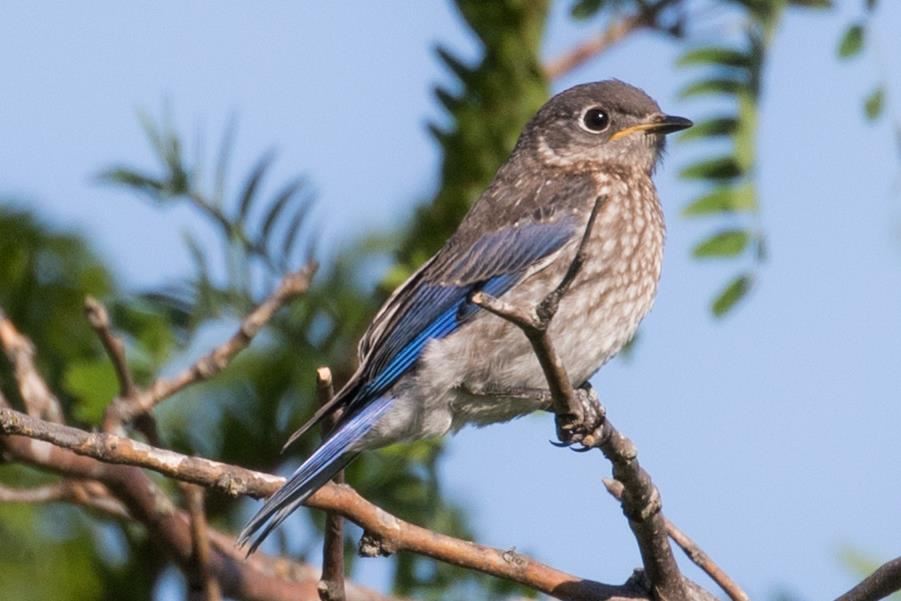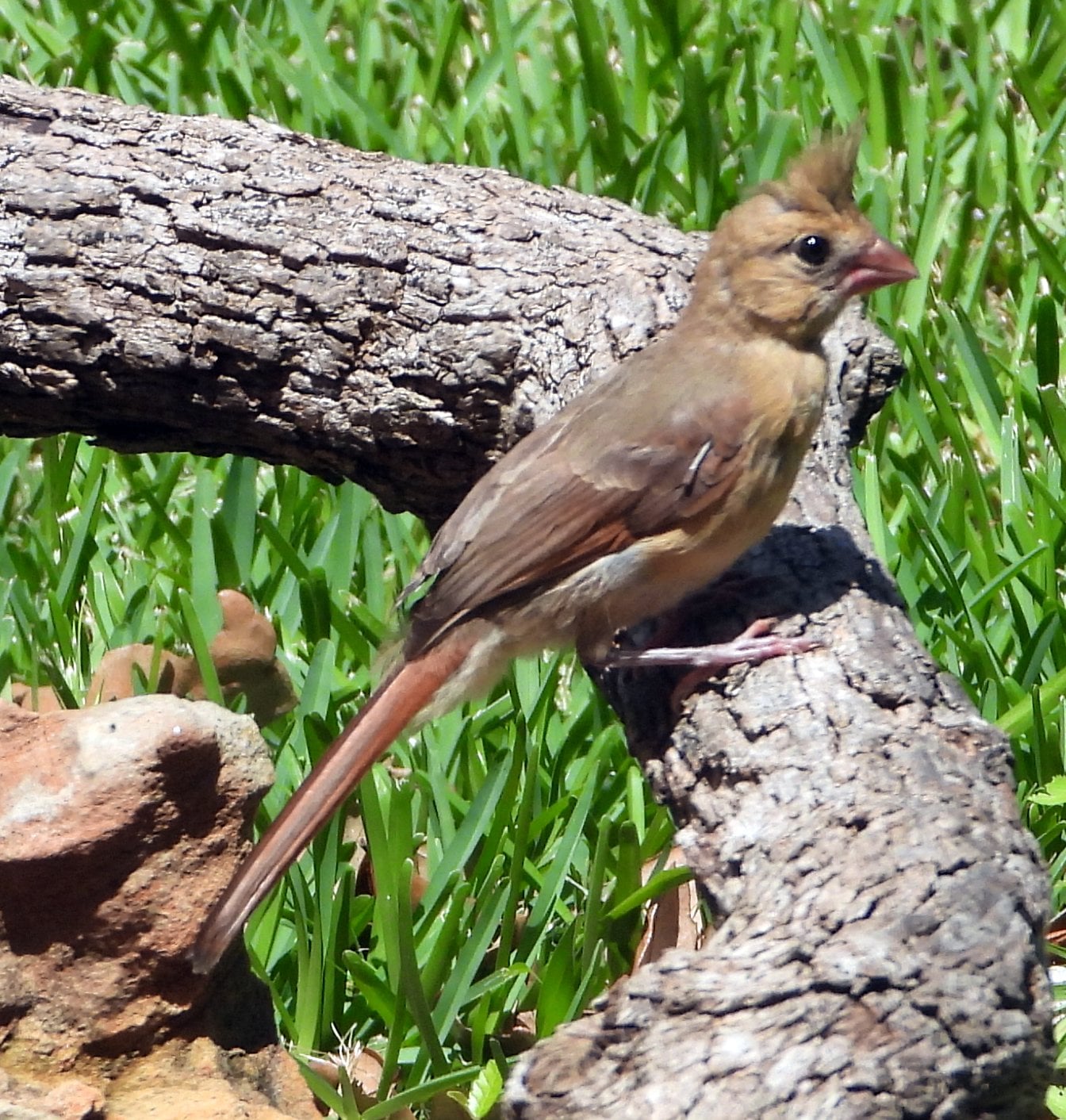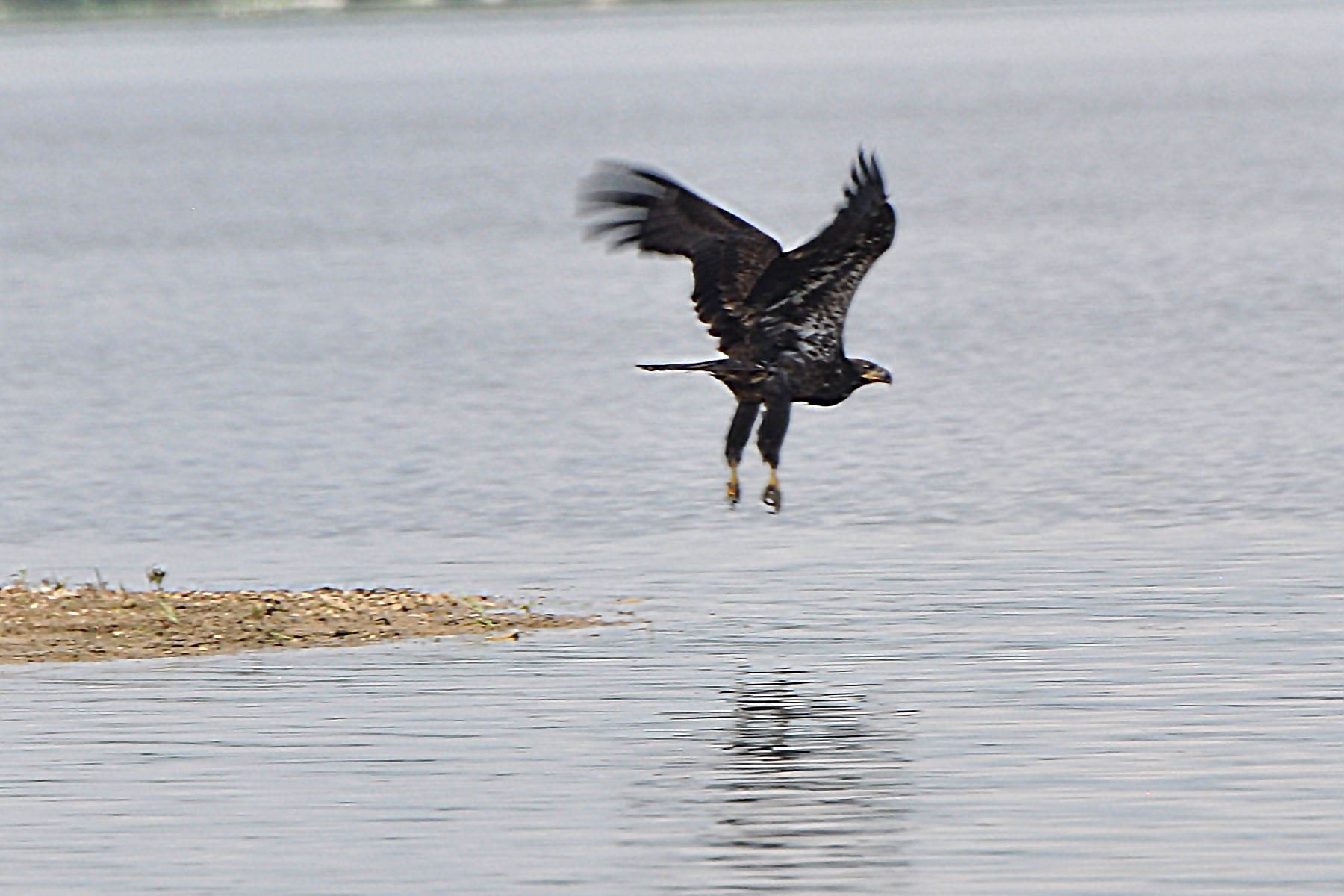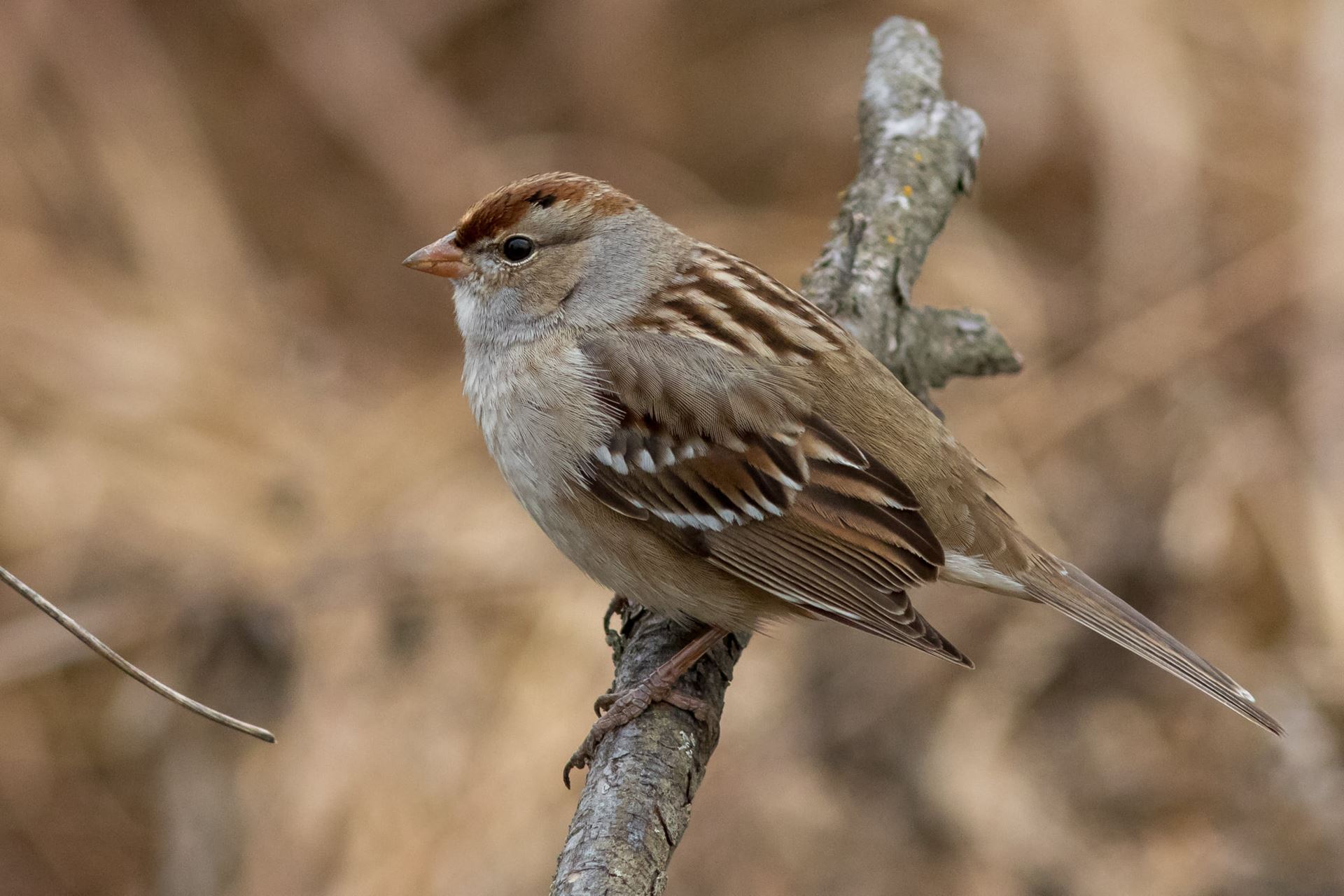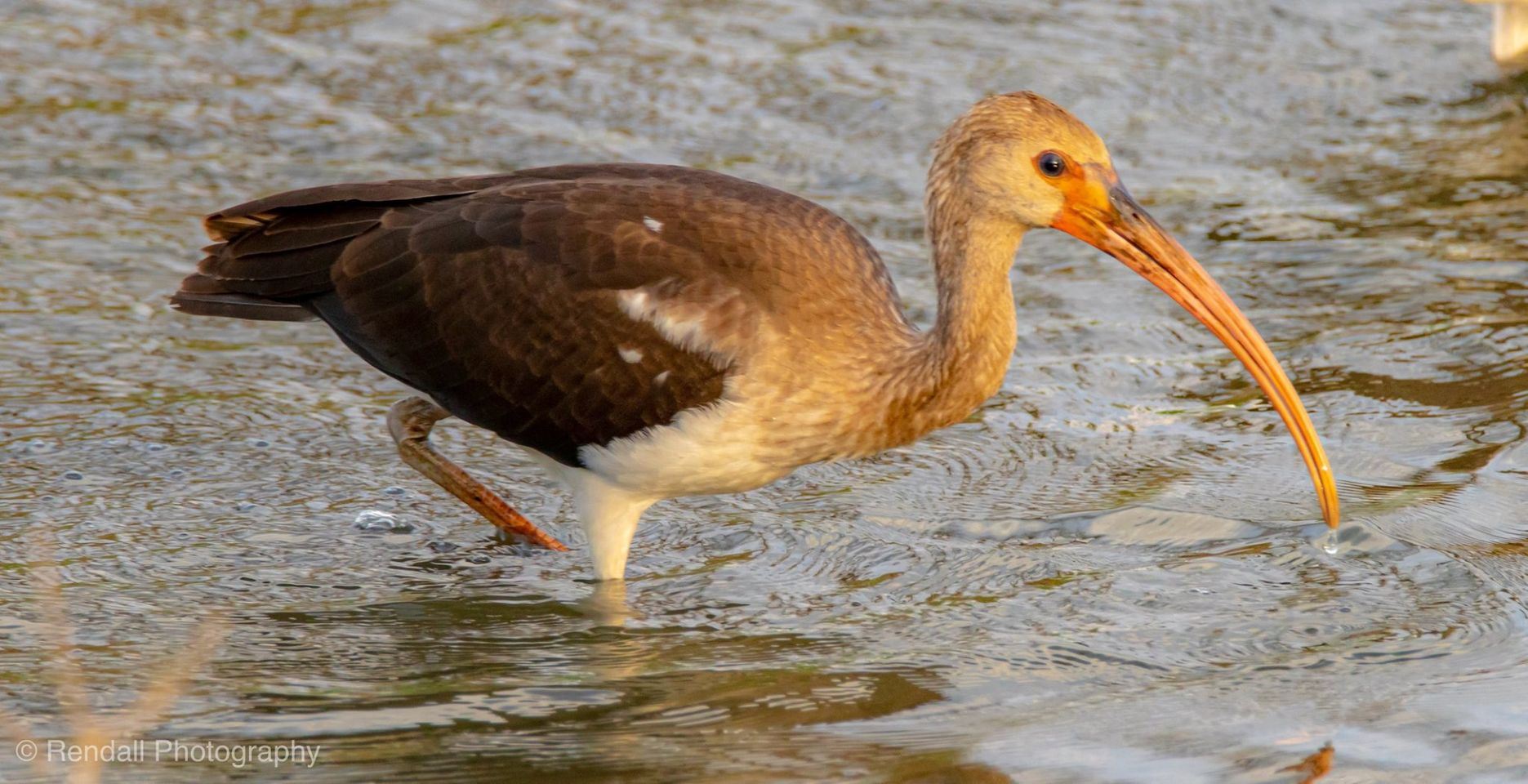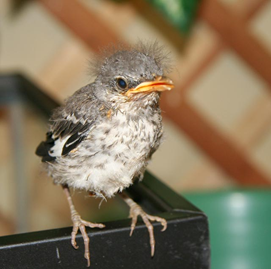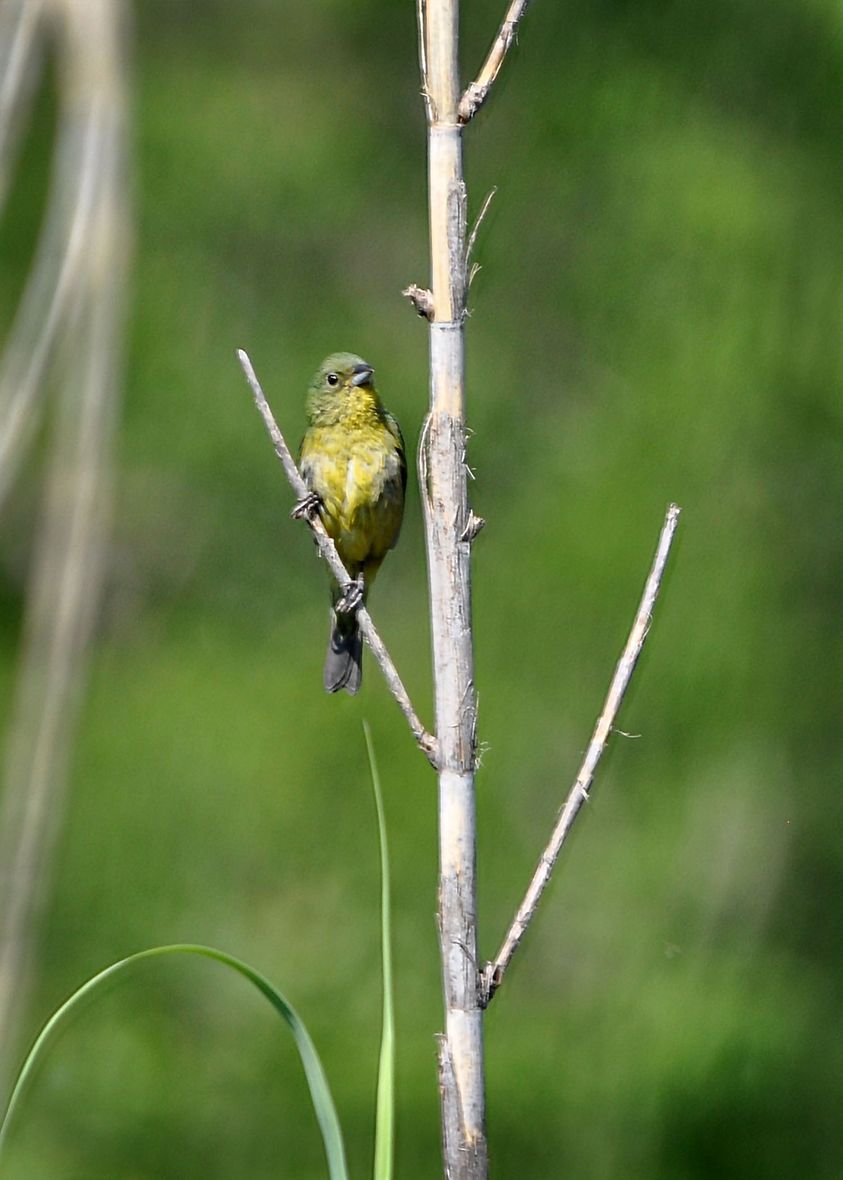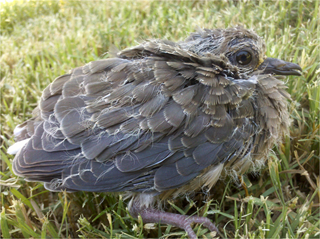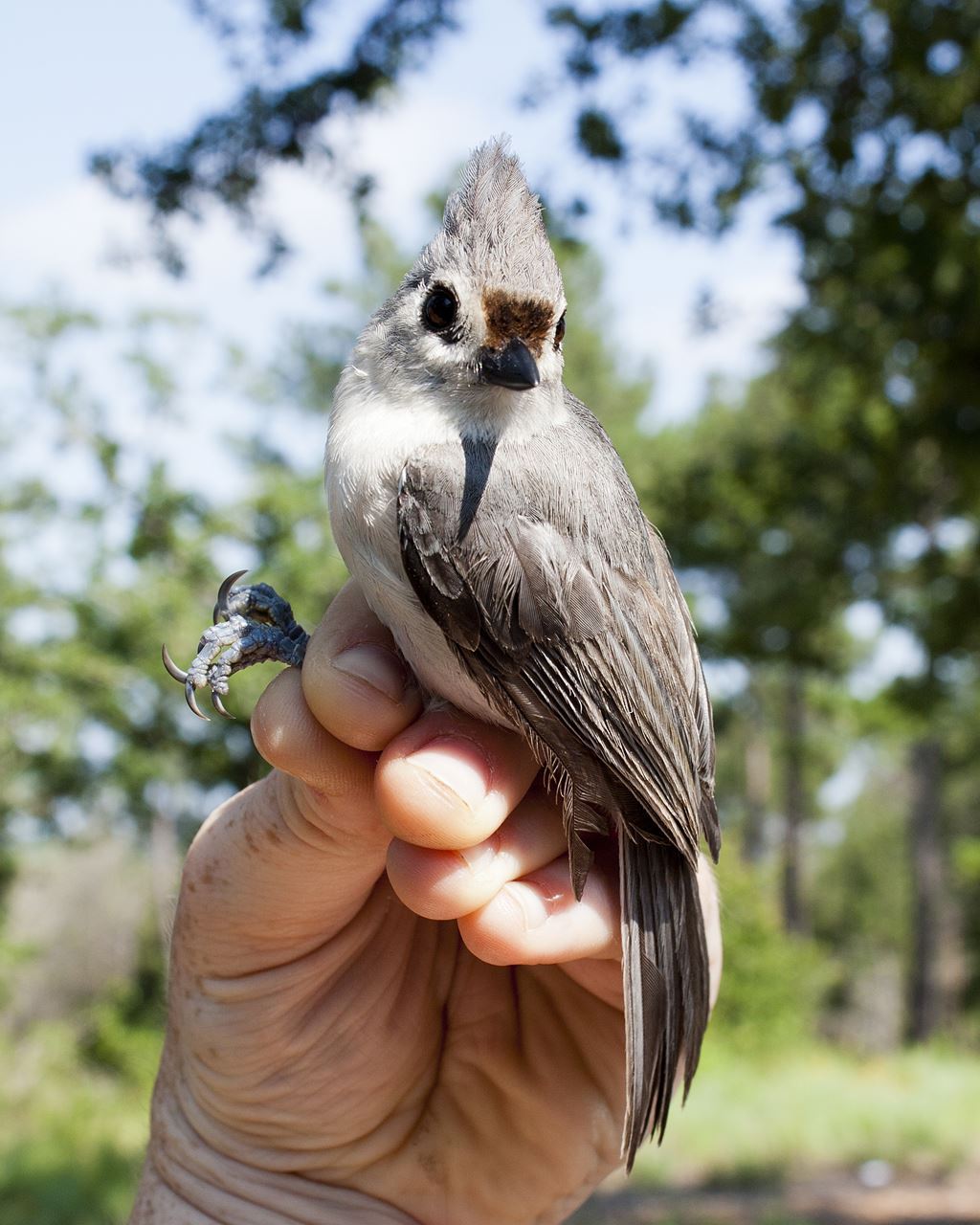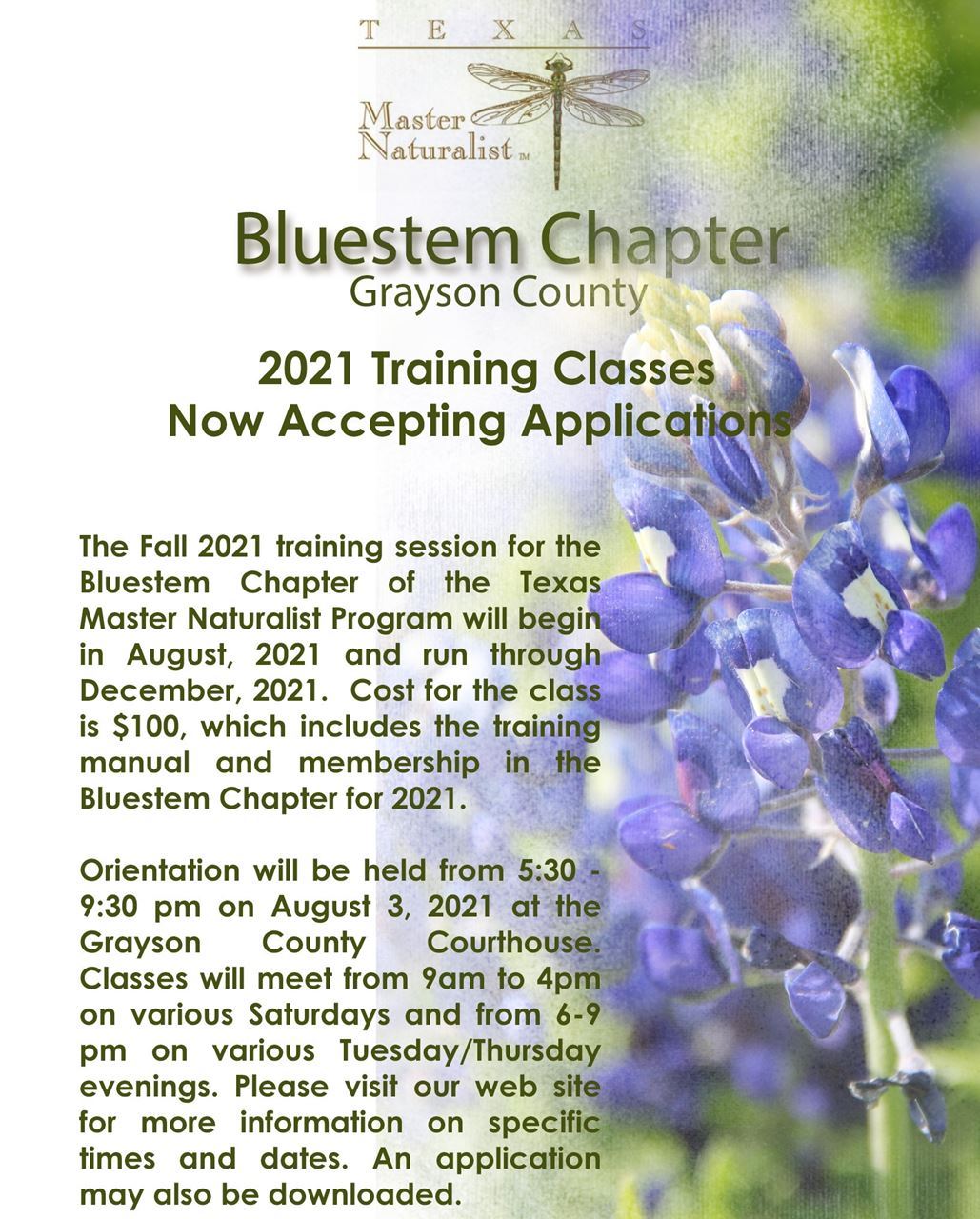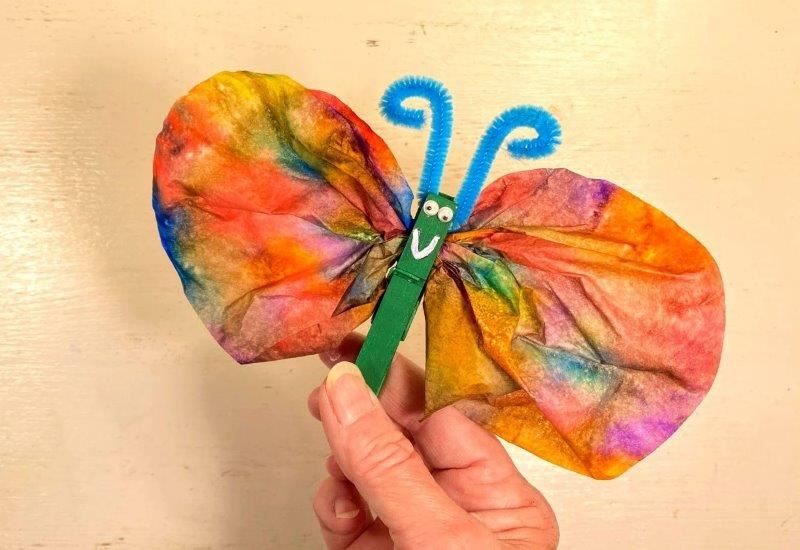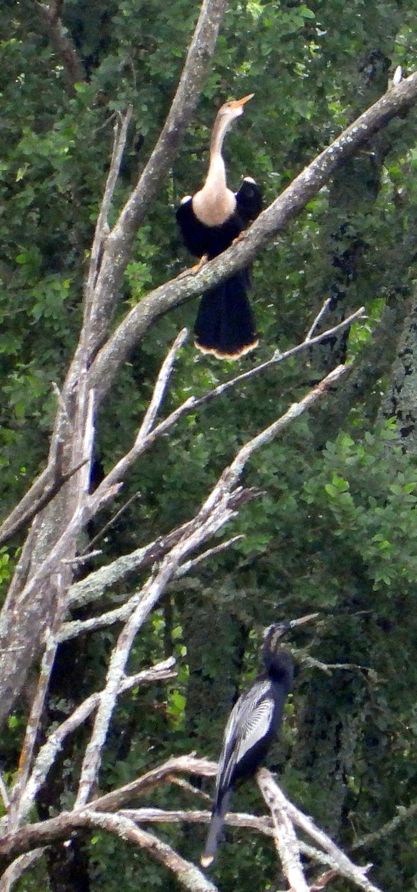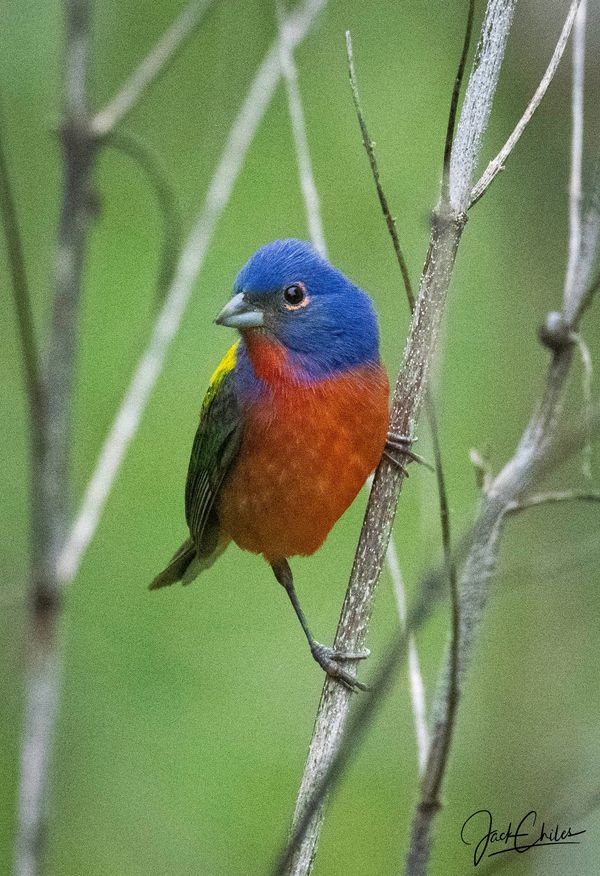
By Renny Gehman
Juvenile Eastern Bluebird by Aaron Hamilton |
At least once a year, I ask myself this question—and I’m sure most birders do also. Sometimes I’m birding far away from home and many birds are new. That’s understandable—and exciting! But what bothers me is a bird at my backyard feeders, or along a familiar trail, that stumps me. Then I noticed it’s usually during late spring/early summer that these “mystery birds” show up. With the help of my birding book, I realized I was trying to identify an immature bird. Just as most of us have changed since our high school graduation pictures were taken, so most young birds resemble their parents, but with noticeable differences. Most of these differences result from a baby bird’s need for camouflage both in the nest and once it’s fledged. Eventually, these |
Juvenile Northern Cardinal By Mike Petrick |
adolescents will molt and replace their body, wing, and tail feathers with adult plumage—usually within the first year but not always. For example, the bald eagle’s distinctive white head doesn’t appear until it is 4-5 years old—and ready to breed. Until then, a juvenile bald eagle passing overhead resembles a golden eagle more than its parents. Most young birds don’t take that long to transition to adult plumage, but until they do, they can confuse an unwary birdwatcher. Still, it is possible to discern if you’ve found a new life bird or if it’s just an immature familiar species. Most bird guides provide pictures of immature individuals, |
Juvenile Bald Eagle by Kitta Weinkauf Dory |
especially if they are easily confused and there are guidelines to make identification easier. Immature birds are classified as nestlings and fledglings. Nestlings are noticeably young, without much feathering; they are most often seen in a nest. A fledgling is older, has more feathers, but cannot fly well. Fledglings often fall from their nest while attempting to exercise their wings and are found near the nest, still chirping, and begging for food. The first step in identifying an immature bird is to curb your enthusiasm. It’s easy to assume you’re observing a rare species—because we all want to find a rare bird or see a species we’ve never |
Juvenile White-Crowned Sparrow By Laurie Sheppard |
identified before. However, before you declare a juvenile bird a rare species, consider the location. Is it a common nesting or breeding area for a familiar regional bird? Next, and related to the previous step, is to see what adult birds are nearby. Most juveniles follow their parents, begging for food and imitating their behavior. It’s worth watching for a while to see if a recognizable adult feeds the bird in question. Of course, brood parasitic birds, like our brown- |
Juvenile White Ibis By Pam Rendall-Bass |
headed cowbird, are exceptions to this rule, but easy to identify once you’re familiar with them. Here in Texas, the cowbird is the most common bird which lays its eggs in other species’ nests. Once you’ve determined you’re dealing with an immature of a local species, field marks become your best way to identify it—just as they are for any bird. However, some field marks in particular are most useful to connect a juvenile with its kind. First, check out the bill. Often the bill seems too large for the bird’s head because their heads have not fully grown, and their feathers haven’t |
Mockingbird Fledgling |
covered the edges yet. But the bill shape/size/color will often give a clue to the species since it rarely changes much. Eyes may seem large for the face, but often will be colored/shaped like an adult bird’s.
Next, notice how immature birds seem “scruffy,” as if their feathers aren’t smoothed down. It takes a while to replace baby down feathers with adult ones, and the mixture makes their outline less sleek, and their silhouette fluffy. Also, tail and wing feathers will seem shortened in proportion to their size because they haven’t grown their full flight feathers yet. Plumage is usually duller, often resembling an adult female and it may have additional speckles, buff-colored edges or a blandness that helps them blend into their surroundings. Open-country birds, like shorebirds, often have cryptic patterns that make them hard to see, while juvenile songbirds lack of distinguishing colors or markings to enable them to disappear into the surrounding foliage. However, most immature birds show similar color/markings to their parents, especially on the wings and tail. For example, an immature red-tailed hawk will have the same dark patches on the leading edge of its wings, and the same brown patches on its stomach as a mature hawk, but its tail will not be red. The red tail feathers do not grow in until after its first molt. So, the key to telling the difference between an immature red-tail and another hawk species is the dark leading wing edge. Also, remember to look at its feet. The orientation of their toes (how many facing forward/ backward) can also help identify species-- |
Juvenile Male Painted Bunting By Kitta Weinkauf Dory
Mourning Dove Fledgling |
especially in shorebirds. Finally, behavior can identify a juvenile. They can act whiny (begging for food), be unsteady on their feet and generally less graceful. In fact, sometimes they just sit there, looking dazed, especially if it’s a nestling that has fallen. Fledglings might be prancing or scurrying around on the ground, looking as if they want to fly, but can’t figure out how. If its behavior seems a little “off,” consider if you’re observing a juvenile. Usually, the period when nestlings or fledglings are commonly seen is short—four to five | 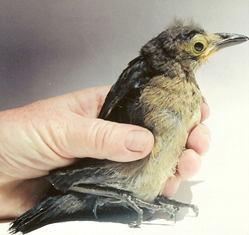 Grackle Fledgling |
weeks. Generally, it is best to leave them alone, since the parent bird(s) will often be close by. If you observe the bird for more than an hour, and no adult bird has returned during that time, you may need to take some action. It is best to contact a veterinarian or wildlife rehabilitation center for advice. While Hagerman NWR does not rehabilitate animals, you can contact the office for information on local rehabilitators. Finally, I was excited to discover that there are two websites specifically designed to help with juvenile bird identification:
|
Notice: Due to the Coronavirus, the Visitor Center remains closed. Refuge lands remain open to the public from sunrise to sunset daily. Restrooms are located at Goode Day Use Area, the Visitor Center, Big Mineral Day Use Area and Sandy Point Day Use Area. See Map Heads Up: Wednesday, May 26: Plover and Tern Roads are closed. The North low water crossing is closed, the low water crossing on Bennett is high but not closed, there is no water on Wildlife or Bennett but that could change quickly. |
The Friends of Hagerman have approved funds to construct a new pavilion. This open-air structure will be located between the Visitor Center, Butterfly Garden and Harris Creek Trail. Read more about how this new facility will be utilized below. We are seeking name suggestions for this pavilion. The structure will be 36’ x 40’ x 18’ tall. It will be open for viewing out from anywhere you sit (most likely on picnic tables). Classes and other group gatherings can be hosted here providing shelter from sun and rain while preserving an open feel. Please submit your suggestion to Friends of Hagerman at friendsofhagerman@gmail.com. Deadline for suggestions is July 10th. .jpg)
|
The Tale of Two Titmice by Jennifer Vaughn June 12th at 10:00 am, Live and Online via ZOOM. All Second Saturday presentations and videos are free and open to the public; powered by Donations and Volunteers. Two species of Titmice, Tufted Titmouse and Black-crested Titmouse, reside across much of Texas and have been suspected of interbreeding for nearly a century. In this talk Jennifer will discuss the historical and current understanding of their species status, her recent research related to their genetics, behavior, physiology, and morphology, as well as potential impacts to their species status in the face of climate change and urban development. |
Jennifer Cary Vaughn grew up in Dallas and earned her bachelor’s degree from Austin College, a master’s degree from Humboldt State University (Arcata, California), and her PhD in Wildlife from Texas A&M University. She is currently teaching Environmental Science and Biology at Collin College’s Frisco campus. |
|
 |
 By David A. Parrish Quercus Macrocarpa Michx Also called, mossy-cup oak, prairie oak; Plant Symbol = QUMA2 Bur Oaks are common in the deciduous forests and prairies of the central United States. They range from southern Canada to the prairies of Texas. Depending on the habitat and the climate, these oaks can be large trees or shrubs. | 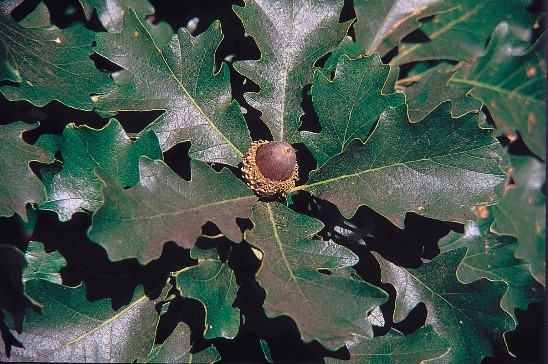 Bur Oak Leaves and Acorn. Herman, D.E., North Dakota State Soil Conservation Committee. |
|
Click below for complete instructions to make a coffee filter butterfly! |
|
Anhinga by Mike Petrick |
And Updated, Weekly Census Results By Jack Chiles
May 25: Bird Census Results Lake Texoma elevation is rising and some of the pad roads are submerged or soon will be. We felt fortunate being able to go down Wildlife Drive. We did get to see a few shorebirds on some of the pad roads since there are no mudflats. The rain held off early on but picked up as the day went on. We walked the short loop of Harris Creek Trail by the photo blind early on and had a Red-headed Woodpecker land near by and give us plenty of looks. On the back side of the |
Painted Bunting by Jack Chiles |
| 
To Our Contributors: Jack Chiles, Renny Gehman, Kitta Weinkauf Dory, Laurie Sheppard, Aaron Hamilton, David A. Parrish, Cindy Steele, Pam Rendall-Bass, Jennifer Vaughn, Mike Petrick Editor: Patricia Crain Refuge Manager: Kathy Whaley Deputy Refuge Manager: Paul Balkenbush Friends of Hagerman NWR Foundation 6465 Refuge Road, Sherman, TX 75092 Phone: 903-786-2826 |

